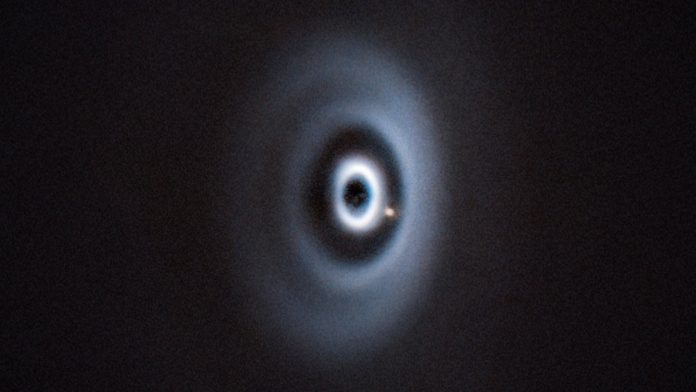Unveiling the Cosmic Cradle: The Astonishing Birth of a New Planet Around a Young Sun
Imagine lying under the vast expanse of a star-studded sky, peering deep into the unfathomable cosmos, when suddenly, a faint glow heralds the birth of a colossal new world. This isn’t a scene from a sci-fi epic; it’s the groundbreaking reality unveiled by an international team of astronomers, spearheaded by passionate researchers at the University of Galway. They have discovered a planet in its cosmic infancy—WISPIT 2b—nestled around a nascent star only 430 light-years from Earth. This revelation adds a brilliant new chapter to our understanding of planetary genesis and our own solar system’s origins.
The Discovery: A Glimpse Into Planetary Dawn
Five million years—a blink in cosmic time—marks the tender age of WISPIT 2b, an immense gas giant roughly the size of Jupiter but far younger and hotter, still glowing from the heat of its tumultuous birth. Detected in a crystalline snapshot captured by the European Southern Observatory’s Very Large Telescope (VLT) perched in Chile’s Atacama Desert, this newfound world circles a star strikingly similar to our Sun’s adolescent self. In the words of Dr Christian Ginski, a principal figure from the University of Galway’s School of Natural Sciences, “We were initially scanning many young stars for fleeting signals of planets, but spotting the multi-ringed dust disk around this star stopped us in our tracks. It was unexpectedly beautiful.”
This discovery sprouted from a survey program out of Leiden University, aptly named WISPIT, which probes how planets dance around their stars at various stages of maturity. The informal and almost playful moniker, WISPIT 2b, sits far better on a cosmic newborn than the unwieldy catalog designation it replaced.
A Cosmic Portrait in Dust and Gas
WISPIT 2b doesn’t exist in isolation—it is cocooned within a sprawling disk of dust and gas, a planet-forming nursery extending 380 astronomical units (AU) from its star. To put this in perspective, that’s 380 times the distance from Earth to our Sun, a gargantuan arena where gravity, gas, and cosmic dust pirouette in silent symphony.
These circumstellar disks, adorned with dramatic rings and spiral arms, are not just visually stunning—they are the raw material and architect’s plans for planets. The intricate structures hint at where protoplanets might be carving their paths, as WISPIT 2b does in its nascent orbit.
The Human Faces Behind the Stars
The breakthrough was orchestrated by a vibrant coalition of early-career scientists, including Richelle van Capelleveen, a talented PhD student at Leiden University, who captivated the community as the project’s lead. “Discovering this planet was an amazing experience—we were incredibly lucky,” Richelle reflects, her voice echoing the serendipity often found in science’s greatest moments.
Back in Galway, Chloe Lawlor, an astrophysics doctoral student, describes the find as “a beautiful example of a planet within its birth disk, offering a living laboratory for testing how planets form.” She considers this landmark discovery a career-defining moment not just for her, but for the entire international team.
Among the team’s many voices is Jake Byrne, a MSc student whose awe was palpable: “When I first saw the image, truthfully, I could hardly believe it was real. It’s a discovery that’s sure to ignite conversations and propel our understanding of planet formation forward.”
Dan McLachlan, another MSc student, recounts the surreal privilege of participation: “Being part of this project was mind-blowing. The University of Galway’s physics department and my supervisor, Dr Ginski, made it possible for me to help rewrite the cosmic story.”
Seeing the Unseen: The Technology that Made it Possible
The extraordinary observations were a result of collaborations across continents—Leiden University and the University of Galway harnessing the VLT’s near-infrared vision to capture the planet glowing like a distant ember, still warm from its fiery formation. This wavelength offers a unique perspective akin to night-vision goggles, allowing astronomers to peer through veils of dust where planets are emerging.
The University of Arizona team provided an indispensable complementary view by detecting WISPIT 2b in visible light, a technical feat revealing the planet is still accreting gas, actively assembling its atmosphere in real time. This dual-wavelength strategy pulls back the cosmic curtain and offers a dynamic, multidimensional snapshot of planetary formation.
Why Does This Matter?
Our solar system’s story begins in a similar dusty cradle, hundreds of millions of years ago. Witnessing a planet’s birth around a star resembling our young Sun provides a precious glimpse of not just history, but the universal mechanics of creation. Observations like these answer fundamental questions: How do giant planets grow? How do they sculpt the dust and gas around their stars? And what variations sculpt the planets’ diverse futures? Each discovery stitches a row of pearls in the necklace of cosmic understanding.
This is only the second confirmed detection of a planet at such an early evolutionary stage around a Sun-like star—the first discovery emanated from the same research ecosystem in 2018, underscoring the steady progress and collaboration fueling planetary science.
Setting Our Sights on the Future
Dr Ginski and his colleagues are not resting on this breathtaking find. “We want to watch how WISPIT 2b moves, how it interacts with its star and the surrounding disk, and how it evolves.” The hope is to revisit this stellar nursery with even more powerful telescopes in the years ahead, peeling back layers of mystery as technology advances.
One can’t help but wonder: How many more such worlds await discovery, hidden in swirling clouds of cosmic dust? What will they tell us about the conditions that gave rise to our own pale blue dot?
Reflections: Our Place in a Vast, Ever-changing Universe
WISPIT 2b’s emergence narrates a familiar yet endlessly enchanting story—the birth of a world. It beckons us to contemplate the astonishing processes that ultimately made our very existence possible. Each speck of dust and every swirl of gas in these distant disks carries the promise of new worlds, perhaps someday homes for life, or just silent sentinels orbiting their stars.
What does this discovery inspire in you? Is it wonder at the vastness of time and space? Curiosity about worlds beyond our grasp? Or a humble appreciation of our fleeting place in the cosmic dance?
As we look upward tonight, remember that humanity is not merely observing distant lights but witnessing deeply personal stories of creation etched across the fabric of the universe.










